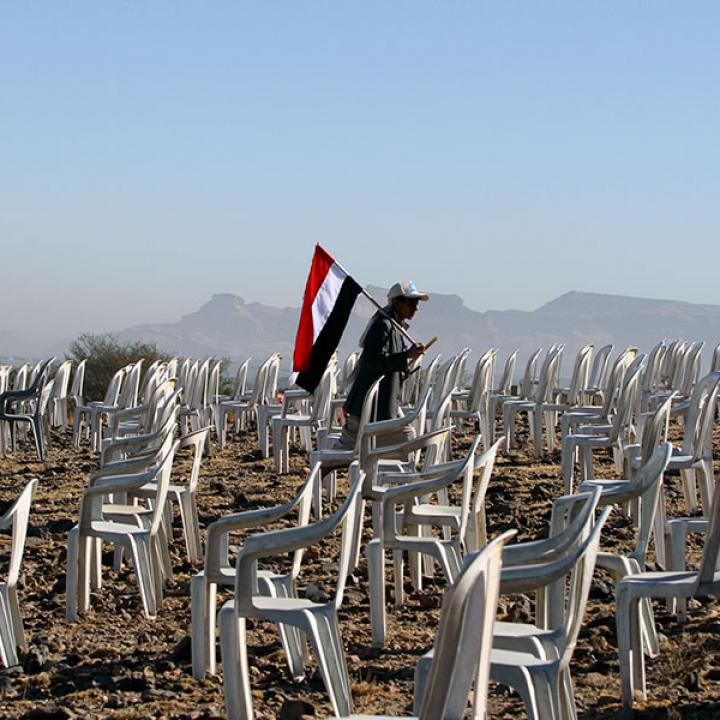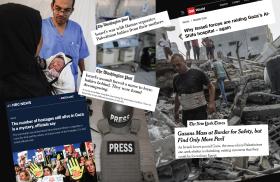

Curbing Iran's foreign meddling and ending the cycle of destructive fighting will require greater political engagement by the Trump administration.
After three years of a grinding, bloody stalemate, the war in Yemen may be reaching an inflection point. Hoping to deliver a knockout blow, the joint United Arab Emirates’ and Yemeni forces are moving up the Red Sea coast towards the port city of Hodeidah. The UAE aims to wrest it from the Houthi rebels, and, in so doing, deprive them of vital revenues, strike a psychological blow, and pressure them to the negotiating table.
Yet even if Hodeidah falls, there is no end in sight for this conflict, whose third anniversary was eclipsed by a recent, splashy visit to the United States from Saudi Crown Prince Mohammed bin Salman. The ambitious young royal launched the war in March 2015 along with the UAE and several other nations to restore the legitimate government of Yemen. Backed by limited U.S. military support, Riyadh and Abu Dhabi sought to disrupt Iran’s nascent efforts to turn the Houthis into a proxy force, and to contain the Islamic State and al-Qaeda in the Arabian Peninsula.
If the Obama administration was never enthusiastic about the Saudi-Emirati enterprise in Yemen, it showed sustained interest in bringing the conflict to an end via a political process, and lent direct U.S. leadership to the effort in its final year. The Trump administration entered office with a stated commitment to knitting up frayed relations with the Gulf and focusing on Iran’s destabilizing activities across the region. Yet ironically, that never translated into a senior-level focus on Yemen, where those strands come tightly together. In fact, U.S. support for the coalition’s campaign has largely been on auto-pilot, when what its Gulf partners needed most over the past 18 months was a sustained diplomatic effort to enable a credible negotiated settlement.
Despite its heady ambitions, the coalition’s bifurcated military efforts—a UAE-led ground force, and the Saudi-led air campaign—have never quite coalesced. Yemen’s internal political dynamics have also hobbled the coalition. Rancor developed rapidly between Yemeni President Abd Rabbu-Mansour Hadi and the UAE, with Hadi accusing Abu Dhabi of usurping governance in the south, and Emirati officials outraged over the apparent corruption and uncoordinated decisions of Hadi’s own rule. Meanwhile, Riyadh’s seeming lack of urgency to wrap up the war (the Saudi Crown Prince has repeatedly asserted that “We will stay until we win”) stood in sharp contrast to the UAE’s early recognition of the need to pivot to a political process, only made more urgent by the disproportionate casualties its forces have suffered.
Prior to the war, Yemen had been one of the few success stories of the Arab Spring. When its longtime despot, former President Ali Abdullah Saleh, faced severe political unrest in 2011, the collective pressures of the United States, Gulf Cooperation Council, United Nations, and key European states secured Saleh’s peaceful exit and set the country on the road to democratic transition. Saleh, never resigned to his removal from power, reemerged in 2014 as the transition reached a critical stage, partnering with the Houthis and enabling their remarkable success in scuttling Yemen’s political transformation and the Hadi government.
Six months ago, that highly transactional alliance blew apart spectacularly, with the Houthis executing Saleh and his party cohorts in cold blood as he looked to switch sides to the coalition. For perhaps the only time in this conflict, the Houthis found themselves—briefly—in the unfamiliar public glare of criticism, including inside Yemen. But the Houthis fight on, with Iran’s carefully cloaked support, as international censure has settled immutably on the Saudi-led coalition.
All the while, Iran’s influence in the broader region has grown. Russia’s support has ensured the survival of Bashar al-Assad in Syria and enabled Iranian and foreign Shia fighters to embed in the country. Meanwhile, the Iran-backed Hezbollah deployed to Syria and won resoundingly at the ballot box in Lebanon. Iran is also flooding Baghdad with money and currying influence to ensure its partners form the next government.
Washington poses a still more complicated picture for the coalition. The latter’s messy prosecution of the war, mounting indicators of famine and disease in a population on the brink even before the conflict, and the absence of a political process for 18 months have sparked a backlash in Congress. A bipartisan Senate effort to press the Trump administration to suspend military support to the coalition failed by a narrow margin, and is certain to be repeated.
Trump’s commitment to containing Iran’s regional predation also seems in doubt. His recent public musings that he would bring U.S. troops home and “let the other people take care of [Syria] now” splashed cold water on overheated Saudi and Emirati expectations of Trump’s staying power (or interest) in the Middle East. Yet, following Trump’s move to pull the United States out of the Iran nuclear accord, Secretary of State Mike Pompeo detailed 12 demands of Tehran, including that it withdraw all forces under its command in Syria, end support for Middle East “terrorist” groups, including Hezbollah, Hamas, and Islamic Jihad, respect the sovereignty of the Iraqi government, permit the disarming, demobilization, and reintegration of Shia militias, and end its support for the Houthis.
Pompeo’s list induced a severe sense of disorientation: What does the Trump administration want? Wholesale retrenchment from the morasses of the Middle East, or a diplomatic and military strategy to induce Iran’s rollback from the region? If the latter, then bringing an end to the war in Yemen should figure urgently into the Trump administration’s Iran-centric regional priorities.
In this regard, time is not on the coalition’s—or Washington’s—side. In less than two years, Tehran has built a small but hardy train-and-equip program for the Houthis, partially contracted out to Hezbollah. With advanced missile-technology transfers, Iran has enabled the Houthis to strike deep into Saudi territory and threaten international shipping in the Bab-al-Mandeb. Iran’s investment is modest, and the returns spectacular.
Any success in crowding out Iran’s involvement in Yemen will require a political solution. A power-sharing formula that offers the Houthis a political—not military—role in the government is widely viewed as a necessary, if fraught, step. Equally challenging: getting Hadi to transition out of power, and convincing the Houthis to hand over their heavy weaponry. Success will require steady, high-level engagement between Washington and Riyadh, Abu Dhabi, and Hadi. As one of the U.S. government’s most astute Yemen experts has noted: “There is a Yemeni solution, and every Yemeni knows it—they just have to be corralled into doing it.”
If the Trump administration wants an early test case of its Iran strategy, there is no more urgent a place to start than Yemen. But the administration will have to commit to focused senior-level engagement with its partners, the UN, and the Hadi government—something that has been absent for 18 months.
Barbara Leaf, the Rosenblatt Distinguished Visiting Fellow at The Washington Institute, formerly served as ambassador to the UAE and director of the State Department’s Office of Iranian Affairs. This article was originally published on the Atlantic website.
Atlantic



